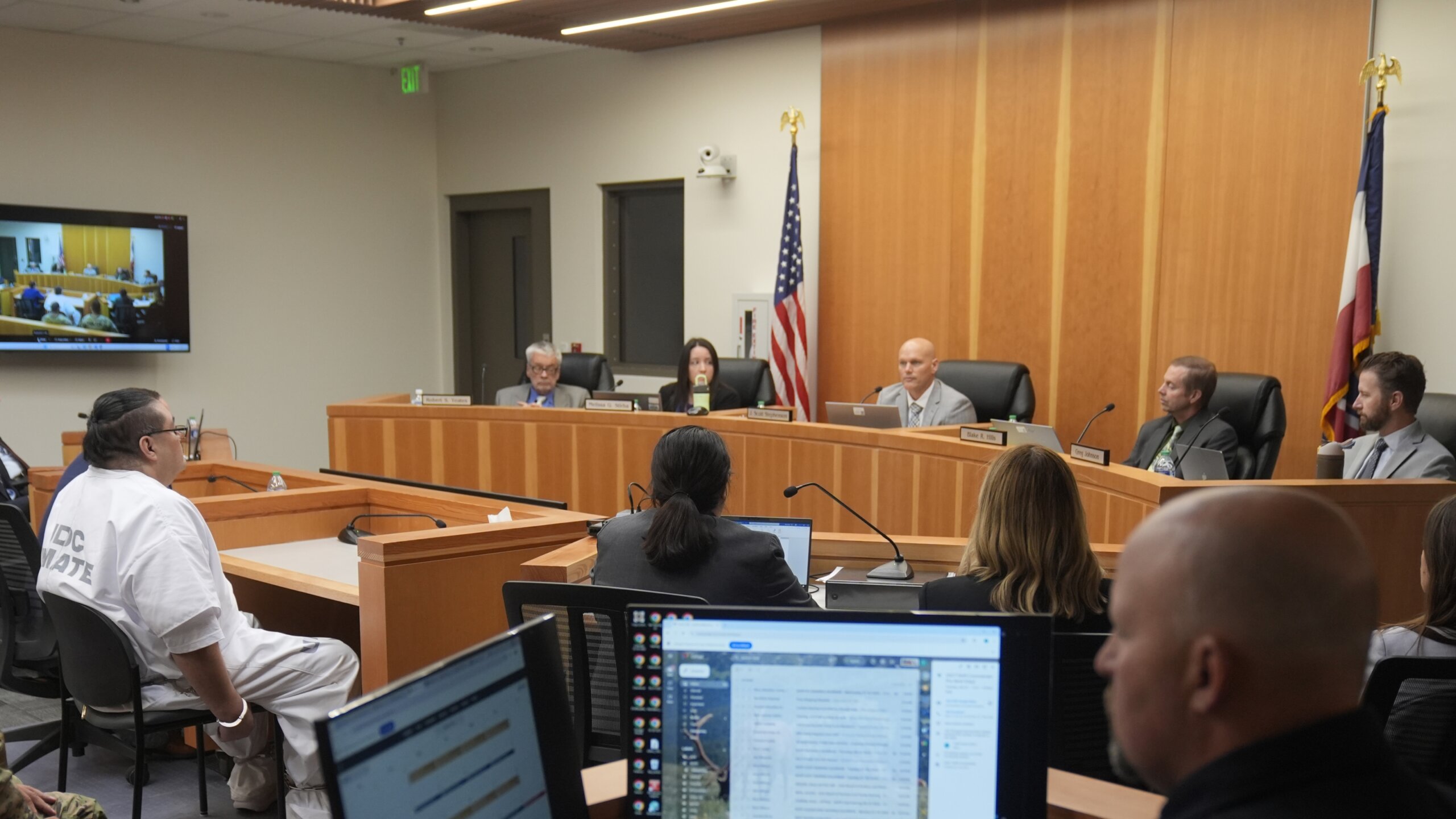Utah
Lakebed dust is a worry in Utah. In California, it’s already a problem

Sitting on the couch next to his mom inside their mobile home in Mecca, California, 5-year-old Ruben Mandujano lets out a gurgled cough while playing on a tablet. The phlegm stuck in his throat is noticeable. But the constant cough is something he’s used to.
His mother, Rosa Mandujano said he came down with some kind of illness about “eight out of the 12 months of the year” when he was younger. Now, after various surgeries, an asthma diagnosis, medications and a nebulizer, Mandujano estimates her son is sick “five months out of the 12.”
The family has grown accustomed to the frequent infections. Both of their children suffer from asthma. A cupboard in their kitchen is dedicated to dozens of over-the-counter and prescription drugs.
Mandujano said her son’s problems get worse when the air quality is awful – another common issue for Coachella and Imperial Valley residents. Mecca, where the Mandujano family lives, is enveloped by agricultural fields and a short distance from the north shore of the declining Salton Sea, a saline lake facing similar turmoil as Utah’s Great Salt Lake.
Dust storms have become the norm being so close to agricultural fields and the Salton Sea, she said. Winds reaching 75 miles per hour whip through predominantly low-income and immigrant communities. The dust gets so bad, Mandujano said, that “you can’t see what’s in front of you.”
Kristin Murphy
/
Deseret News
With the exposed Salton Sea lakebed and the loose dirt and pesticides from the surrounding fields, Mandujano said it’s rare to find a Coachella Valley resident who doesn’t suffer from allergies or asthma. But the impact of the bad air quality and dust storms is worse for some, like Ruben.
“His asthma and his allergies combine, it’s a ticking bomb for him,” Mandujano said. “He says that everything hurts. His ears hurt, his eyes hurt, his nose hurts. He doesn’t even want to get touched.”
When the phlegm won’t leave his throat, Ruben has to use a nebulizer, which circulates well-known asthma medications like Albuterol or Pulmicort through a mask. Mandujano said she hooks her son up to the nebulizer about 121 times a year.
“He hates it because it makes him throw up because it gathers all of the phlegm,” Mandujano said. “He knows he’s going to start throwing up. So he just says, ‘Mommy, I don’t like this,’ and keeps trying to take it off.”
While Rosa Mandujano fights to keep her family healthy, California state leaders, scientists and community advocates are trying to identify solutions to clean up the air, especially as it pertains to the dust accumulated from the Salton Sea. Like Great Salt Lake, there are toxins in the sediment of the exposed lake bed.

Kristin Murphy
/
Deseret News
Scattered near the roughly 27,000 acres of exposed Salton Sea playa are lines of hay bales.
Charlie Diamond, a researcher with the Salton Sea Task Force at the University of California Riverside, said it’s a “dust suppression project” aimed to “break up the flow of air right at the ground level.” The goal, Diamond said, is for the hay bales to “suppress the dust production or emission.”
During high wind events, Diamond said toxins and other sediments like gypsum and salt get “blown around in the surrounding communities, [and] causes a lot of problems with respiratory health, especially in young folks.”
Usually, Diamond said, the hay bales are planted with native vegetation, which the shoreline severely lacks. That acts as another dust suppressant. But “these projects are really contingent on some external source of freshwater,” Diamond added, and that’s the crux of the issue – in the arid climate, there isn’t enough fresh water making its way to the Salton Sea to begin with.
With an exorbitant amount of dried lakebed, it’s unlikely hay bales will prevent all the dust from pummeling community members.
“That’s not a solution, it’s a band-aid,” Diamond said.
Local officials are working on other remedies. The Imperial Irrigation District, which oversees the hay bale projects, is also planting and germinating natural vegetation near the shoreline. Environmental specialist Ross Wilson said the district is using groundwater to hydrate the plants.

Kristin Murphy
/
Deseret News
Wilson said there isn’t a way to “necessarily make less dust,” the hope is the natural vegetation “catches the dust” like the hay bales and results in better air quality.
The agency also uses a Portable In-Situ Wind ERosion Lab, also known as a PI-SWERL, to figure out what exactly is in the dust. The device, which resembles an industrial floor polisher, replicates wind speeds and collects air quality measurements. Wilson added it also tracks which areas produce the most emissions.
“No one has the money to just mitigate the entire sea. So if we can dial down which areas actually are emissive and which areas are the problem, then we can really nail down our resources to those specific areas,” he said.
If more water isn’t funneled into the Salton Sea, the Imperial Irrigation District predicts upward of 70,000 acres of bare lakebed within the next 10 years.
Utah’s Great Salt Lake is up against the same fate as the Salton Sea when it comes to dust.

Kristin Murphy
/
Deseret News
Great Salt Lake Commissioner Brian Steed noted in the state’s first Great Salt Lake Strategic Plan that the lake’s low water levels are increasing dust emissions. He added the accumulation from the estimated 800 square miles of the exposed lake bed poses a public health risk and is causing snow to melt approximately 17 days sooner than normal.
Steed told KUER’s RadioWest that he believes dust from Great Salt Lake is “going to be the hardest one [problem] to solve.”
“When you have an exposed lake bed that weathers over time, which has happened over years, you see additional dust days and problems with PM 2.5 and PM 10,” he said. “And we know that we’ve had a problem [with air quality] along the Wasatch Front especially.”
The Utah Office of Legislative Auditor General highlighted in the Great Salt Lake Strategic Plan that it would cost a minimum of $1.5 billion to keep the lake’s dust at bay, along with $15 million each year for ongoing maintenance.
Steed recognizes the price tag associated with dust mitigation. In an ideal world, “the lowest cost alternative” is lifting Great Salt Lake’s water levels so the crust “keeps that dust in place.”

Kristin Murphy
/
Deseret News
Utah is just beginning to grapple with its looming dust problem, but for Rosa Mandujano in California, the dust is enough to make her contemplate if it’s worth staying in her hometown. Her two kids love to be outdoors, but the air quality often triggers adverse reactions, especially for Ruben, forcing them to remain inside.
“I’ve talked to my husband and said if we get a good job opportunity and we would have to move out of the state, I mean, let’s go,” Mandujano said. “I know it’s scary because my family’s here. All his family’s here, but I’ve seen friends done it. It’s nothing out of the world. You have to start somewhere.”
KSLTV5’s Alex Cabrero contributed to this report
Copyright 2024 KUER 90.1

Utah
Utah officials deny clemency for man set to be executed for 1998 killing of his girlfriend’s mother – WTOP News

SALT LAKE CITY (AP) — Utah officials denied clemency Friday to a man who is set to be executed for…
SALT LAKE CITY (AP) — Utah officials denied clemency Friday to a man who is set to be executed for the stabbing death of his girlfriend’s mother in 1998.
The decision regarding the fate of Taberon Dave Honie, who is scheduled to die by lethal injection Aug. 8, was announced in a one-paragraph notice from Scott Stephenson, chair of the Utah Board of Pardons and Parole.
“After carefully reviewing all submitted information and considering all arguments from the parties, the Board does not find sufficient cause to commute Mr. Honie’s death sentence,” Stephenson wrote.
During a two-day commutation hearing this week, Honie asked the parole board to commute his sentence to life in prison, saying he would never have killed 49-year-old Claudia Benn after a day of heavy drinking and drug use had he been in his “right mind.”
Honie said he wanted to continue to live to be a support for his mother and his daughter. His attorneys did not immediately respond to telephone and email messages seeking comment on the clemency denial.
Benn’s family urged the parole board to allow him to be executed, saying they have been devastated by their loss.
They described Benn as a pillar in their family and southwestern Utah community — a tribal council member, substance abuse counselor and caregiver for her children and grandchildren.
Honie, who had a volatile relationship with Benn’s daughter, broke into the victim’s house in Cedar City, the tribal headquarters of the Paiute Indian Tribe of Utah, on July 9, 1998.
He repeatedly slashed her throat and then stabbed her. Benn’s grandchildren, including Honie’s 2-year-old daughter, were in the house at the time.
“The way he killed her, that’s just sick. … An eye for an eye, as God says it,” Sarah China Azule, Benn’s niece, said during testimony.
Honie was convicted in 1999 of aggravated murder. The judge who sentenced him to death found that Honie had sexually abused one of the children, one of the aggravating factors used to reach that decision.
During the hearing, Honie’s attorneys presented testimony describing his traumatic childhood growing up on the Hopi Indian Reservation in Arizona.
His parents, like many Native Americans, had been put into into government boarding schools that were often abusive, and the defense argued that they did not learn parenting skills, were heavy drinkers and neglected Honie, who began drinking and using drugs including cocaine, heroin and methamphetamine by the time he was a teenager.
But the state told the board that Honie created more trauma by killing Benn.
“Imagine the intergenerational traumas from Honie’s horrific acts trickling down through time,” Assistant Solicitor General Daniel Boyer said.
Utah has not had an execution since Ronnie Lee Gardner was put to death by firing squad in 2010.
Honie is one of six people awaiting execution in the state. The death sentence for a seventh person, Douglas Lovell, who killed a woman to keep her from testifying against him in a rape case, was overturned Thursday by the Utah Supreme Court. He will be resentenced.
After decades of failed appeals, Honie’s execution warrant was signed in June despite defense objections to the planned combination of the sedative ketamine, the anesthetic fentanyl and potassium chloride to stop his heart. When Honie’s attorneys sued, corrections officials agreed to switch to pentobarbital but the case is still pending.
One of his lawyers said previously that the defense was reviewing information regarding the change and working to protect his constitutional rights.
“Serious uncertainty still remains about the state’s last-minute execution plan,” attorney Eric Zuckerman said.
Prison officials have agreed to let one of Honie’s lawyers have access to a phone while witnessing the execution in case an emergency motion needs filing, according to a Wednesday court order.
___
Slevin reported from Denver, and Brown from Billings, Montana.
Copyright
© 2024 The Associated Press. All rights reserved. This material may not be published, broadcast, written or redistributed.
Utah
Temps drop with storms lingering across Northern and Central Utah

SALT LAKE CITY (ABC4) — This week, we’ve seen record heat, flash flooding in parts of Southern Utah, and strong thunderstorms impact parts of the Wasatch Front. A drier air mass moves in from the southwest today, but there will still be enough lingering moisture for isolated thunderstorms. As we close out the work week temperature-wise, we are seeing more seasonal temperatures as our ridge of high pressure breaks down and pulls southeast. Daytime highs will be in the mid-90s along the Wasatch Front with more triple-digit temperatures for St. George.
FRIDAY: Lingering moisture allows for isolated t-storms in the afternoon/evening as a trailing disturbance behind the main cold front moves through. Marginal risk for storms for parts of West Desert & Wasatch Front. Seasonal temps in the north, hot still in South- #utwx pic.twitter.com/pF05kqoAtF
— Alana Brophy (@AlanaBrophyWX) July 26, 2024
With isolated storms possible, we have a ‘Marginal’ risk of isolated severe thunderstorms for parts of the West Desert Utah, including portions of the Wasatch Front this evening where the primary threat will be strong wind gusts. Severe thunderstorms can bring an abundance of lightning, wind gusts of 58+ mph, and large hail. St. George only has a slight chance of a storm today, and our flash flood risk is still possible for many locations including our National Parks except Zion and near Lake Powell.
Another weak disturbance brushing by on Saturday will bring a few showers and thunderstorms to northern Utah. Drier air in the south should end the storms, but strong southwesterly winds could create critical fire weather conditions. A fire weather watch has been issued for Saturday afternoon for portions of Central and Southern Utah due to the potential of gusty winds to 35 mph and low relative humidity.
FIRE WEATHER WATCH: This is for Saturday as significant drying takes place across southern & central Utah. SW winds increase leading to the potential for critical fire weather conditions due to gusty winds and low humidities across southern and portions of central Utah#utwx pic.twitter.com/SU4qrO9bkA
— Alana Brophy (@AlanaBrophyWX) July 26, 2024
By Saturday, drier air moving in from the southwest will push moisture out of the state Saturday evening. Sunday will be dry across the region with seasonal highs and lighter winds. The ridge will rebuild over the area early next week with a rebound to above-normal temperatures through midweek. Moisture will also return to areas of southern Utah by midweek, increasing chances of afternoon thunderstorms.
Copyright 2024 Nexstar Media, Inc. All rights reserved. This material may not be published, broadcast, rewritten, or redistributed.
For the latest news, weather, sports, and streaming video, head to ABC4 Utah.
Utah
Is JD Vance’s working-class conservatism the future of the GOP? Utah's youngest lawmaker hopes the answer is 'yes'
Utah’s youngest state lawmaker brought his working-class roots to Washington, D.C., this month as part of a movement trying to change the course of the Republican Party.
Rep. Tyler Clancy, R-Provo, age 27, spoke on July 9 at the fourth “National Conservatism” convention, comprised of political leaders, professors and policy wonks hoping to steer the GOP away from corporate influence and toward a blue-collar populism to advance an “America First” agenda.
“As elected officials, we have more accountability to the people of America rather than companies that try to run this country,” Clancy said during his speech. Republicans are tasked with being a “check on the centralization of power by a few,” Clancy said, whether that be in the federal government or the marketplace.
Concluding the three-day-long event was an address from Ohio Sen. JD Vance, featuring a more culturally aggressive, less economically laissez-faire approach to GOP governance. Less than a week later, Vance was chosen by former President Donald Trump as his vice presidential pick in the 2024 general election and declared, by some, as the new face of the Republican Party.
While Clancy considers himself a limited-government conservative, the up-and-coming state lawmaker believes Vance is representative of an emerging crop of Republican leaders who view policy areas like more family benefits, bringing manufacturing jobs back to the U.S. and regulating “big pharma” as just as essential to conserving the American Dream as pushing for lower taxes on businesses.
“I definitely think you’ll see a shift with the younger generation,” Clancy said in an interview with the Deseret News. “We want to stand up for the working class, we want to make sure that people who are in this country and work hard and play by the rules can feed their families, make sure one medical emergency doesn’t put them into bankruptcy and make sure that we’re balancing all interests, not putting some over others, i.e., Wall Street and massive multi-national corporations.”
An evolving Republican Party
Nearly one hundred years ago, the Republican Party redefined itself in opposition to the New Deal’s tax-and-spend welfare state.
As the de facto party of smaller government, the GOP developed a “strong pro-business constituency” who benefited from lower taxes, fewer regulations and limited government intervention in the economy, said Damon Cann, chair of the political science department at Utah State University and former mayor of North Logan from 2018-2021.
But, according to Cann, Trump’s 2016 ascendancy, propelled by shift in support from white-collar to working class voters, is not without precedent in the Grand Old Party.
“There have been elements of these attitudes and beliefs lying just below the surface in the Republican Party, and I think it’s more that Trump capitalized on them than he created them,” Cann said.
The Great Recession of 2008, the collapsing trust in institutions and the influence of globalization set the stage for a GOP base that was more willing to reject elite economic opinion and international trade agreements in favor of preserving entitlement programs and subsidizing American industries, Cann said.
An example of this change in tone can be seen in Mitt Romney’s prescription in 2008 to encourage the market’s creative destruction by “letting Detroit go bankrupt”, compared to what Cann said was Trump’s message: “I’m going to fight for the lower and middle class workers who are falling as victims of globalization, whose jobs are being outsourced from United States.”
Trump’s new running-mate Vance has stated his support for the former president’s proposed agenda of “broad-based tariffs, especially on goods coming in from China” to “protect American industries from all of the competition.” Vance has introduced new railway safety regulations and has praised the Biden-appointed Federal Trade Commission Chair Lina Khan, known for her aggressive antitrust stance against large tech companies, as “doing a pretty good job.”
Maybe the biggest indicator yet of the GOP’s increasing openness to populist economic policies was the invitation for Sean O’Brien, the president of Teamsters, one of the nation’s largest private sector unions, to speak at the Republican National Convention last week.
Clancy, who has the endorsement of the Teamsters’ local chapter and the operating engineers union in Utah, said he was excited to see organized labor “start to play a role again in Republican politics.”
“Unions are a puzzle piece of our economy and help workers bargain for better wages, better worker safety, health insurance, pensions, etc.,” Clancy said.
Can the GOP be pro-business and pro-worker?
The GOP is unlikely to lose its business constituency even if Republicans continue to flirt with pro-union figures, or feature proposals to increase regulations on “big tech” or revoke China’s favored trading status, because “where else will they go?” Cann said.
“At least at present, the Democratic Party isn’t offering an attractive alternative to Republicans,” Cann said.
But it’s not the change in rhetoric that worries Derek Miller, the president and CEO of Salt Lake Chamber. It’s the prospect of a Republican Party that ceases to prioritize the principles that promote job growth and prevent economic stagnation — the principles, Miller said, that have allowed Utah to build “the most robust and prosperous economy” in the nation by “unleashing the power of free enterprise.”
“We talk about economy, we talk about business, but at the end of the day what we’re really talking about is people,” said Miller, who previously served as chief of staff to former Gov. Gary Herbert. “It’s people who start businesses. It’s people who run businesses. It’s people who make businesses successful. So to that the extent the Republican Party wants to be more focused on people I think that’s a welcome thing.”
As a former staffer in Washington, D.C., and then as the director of Utah’s Department of Commerce and the Governor’s Office of Economic Development, Miller said he has seen how tried and true Republican instincts to get government out of business lead to positive impacts for Americans.
Miller said regulations are critical to “protecting the public” and “creating a level playing field for businesses.” But, he added, “I can’t think of a single thing that would jumpstart our national economy more” than getting rid of excessive regulation.
For Clancy, the shift he most wants to see within his party isn’t necessarily toward, or away from, specific free market policies. It’s a shift toward addressing the needs of working families who haven’t traditionally had much access to political representation and bringing “hope to this part of America that’s been left behind.”
“As public servants, we shouldn’t limit ourselves to a religious-type orthodoxy of political leaders in the past,” Clancy said. “It’s more of a call for leaders to really dig in, learn the needs of our community and apply those conservative principles to 21st century problems.”
-

 World1 week ago
World1 week agoOne dead after car crashes into restaurant in Paris
-

 Midwest1 week ago
Midwest1 week agoMichigan rep posts video response to Stephen Colbert's joke about his RNC speech: 'Touché'
-

 News1 week ago
News1 week agoVideo: Young Republicans on Why Their Party Isn’t Reaching Gen Z (And What They Can Do About It)
-

 Movie Reviews1 week ago
Movie Reviews1 week agoMovie Review: A new generation drives into the storm in rousing ‘Twisters’
-

 News1 week ago
News1 week agoIn Milwaukee, Black Voters Struggle to Find a Home With Either Party
-

 Politics1 week ago
Politics1 week agoFox News Politics: The Call is Coming from Inside the House
-

 News1 week ago
News1 week agoVideo: J.D. Vance Accepts Vice-Presidential Nomination
-

 World1 week ago
World1 week agoTrump to take RNC stage for first speech since assassination attempt



















